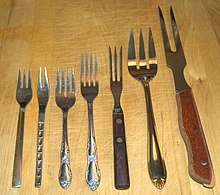From Wikipedia, the free encyclopedia

Assorted forks. From left to right: dessert fork, relish fork, salad
fork, dinner fork, cold cuts fork, serving fork, carving fork.
As a piece of
cutlery or
kitchenware, a
fork is a tool consisting of a handle with several narrow
tines on one end. The fork as an eating utensil has been a feature primarily of the West, whereas in East Asia
chopsticks
have been more prevalent. Today, forks are increasingly available
throughout East Asia. The utensil (usually metal) is used to lift food
to the mouth or to hold ingredients in place while cooking or cutting
them. Food can be lifted either by spearing it on the tines, or by
holding it on top of the tines, which are often curved slightly. For
this former function, in the
American style of fork etiquette, the fork is held with tines curving up; however, in
continental style, the fork is held with the tines curving down.
[citation needed] A fork is also shaped in the form of a trident but curved at the joint of the handle to the points.
Though the fork's early history is obscure, the fork as a kitchen and
dining utensil is generally believed to have originated in the
Roman Empire, or perhaps in
Ancient Greece (though there is some evidence of its use in Mesopotamia
[1] [2]). The personal table fork most likely originated in the
Eastern Roman, or
Byzantine,
Empire. Its use spread to what is now the Middle East during the first
millennium CE and then spread into southern Europe during the second
millennium. It did not become common in northern Europe until the 18th
century and was not common in North America until the 19th century.

Tidak ada komentar:
Posting Komentar